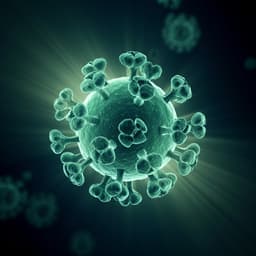
Mathematics
Mathematical modelling of the dynamics and containment of COVID-19 in Ukraine
Y. N. Kyrychko, K. B. Blyuss, et al.
This paper presents a cutting-edge mathematical model of COVID-19 dynamics in Ukraine, utilizing age-stratified parameters to accurately predict case and death rates. The research shows that minimizing work contacts proves more effective in combating the disease than reducing school interactions or focusing solely on the elderly. This compelling study was conducted by Yuliya N. Kyrychko, Konstantin B. Blyuss, and Igor Brovchenko.
~3 min • Beginner • English
Introduction
The COVID-19 outbreak emerged in Wuhan, China in December 2019 and rapidly became a global pandemic declared by WHO on 11 March 2020. In the absence of vaccines or effective disease-specific antivirals, many countries implemented non-pharmaceutical interventions (NPIs) such as quarantines, lockdowns, border closures, and social distancing, which modelling studies have shown to be effective at reducing transmission. SARS-CoV-2 transmits primarily via the respiratory route; a substantial fraction of infections are asymptomatic (estimated 50–75%), viral loads in symptomatic and asymptomatic individuals can be similar, and disease severity and mortality increase markedly with age and comorbidities. Ukraine reported its first confirmed COVID-19 case on 3 March 2020 and introduced a nationwide quarantine on 12 March 2020. Despite restrictions, cases rose, surpassing 100 confirmed cases by 25 March 2020, prompting further tightening of measures on 6 April 2020. Early lockdown slowed progression, with the doubling time of cases increasing from about 8 days to 11–13 days between late April and early May. With gradual easing from mid-May to early June 2020, daily cases began to increase. This study develops an age-structured SEIR-type model, calibrated to Ukrainian data, to understand COVID-19 dynamics, produce short-term forecasts, and assess the impact of different lockdown strategies on cases and deaths.
Literature Review
The study builds on prior modelling of COVID-19 transmission and NPIs across multiple countries, which showed social distancing, isolation, testing, and contact tracing reduce transmission. It extends earlier work by Blyuss and Kyrychko on latency and age structure for the UK and by Brovchenko on mean-field dynamics in Ukraine. Empirical studies indicate gamma-distributed incubation, infectious, hospital recovery, and time-to-death periods; similar distributions have been reported internationally. Contact patterns are critical for transmission modelling; the authors use age- and setting-specific contact matrices derived from the POLYMOD project and its extensions by Prem et al., which project contact matrices to many countries including Ukraine, and are conceptually related to more recent UK-specific datasets (e.g., BBC Pandemic). Age-specific clinical parameters (asymptomatic proportions, hospitalisation and fatality ratios) are informed by Ukrainian Public Health Center data and literature (e.g., Davies et al.).
Methodology
Design: An age-structured SEIR-type compartmental model with realistic (gamma-distributed) stage durations and setting-specific contacts was developed, stratified into sixteen 5-year age groups (0–4 up to 75+).
Compartments: S (susceptible), E (exposed; multiple stages to represent gamma-distributed incubation), I (infectious; multiple stages for gamma-distributed infectious period), RA (asymptomatic recovered), RM (recovered from mild symptomatic infection), Is (severe cases requiring hospital care who recover; represented via staged hospital recovery), D (deaths; via staged time to death). A proportion of infectious individuals become asymptomatic and recover (PA), a proportion develop mild symptoms and recover (PM), and a proportion require hospitalisation (pH). Among hospitalised, a fraction ps recovers (to RS) and pr dies (to D).
Time distributions: Key periods were modelled with gamma distributions implemented as k-stage chains with common mean: incubation Tinc (mean ≈ 4.9 days, K1=2), infectious period Tinf (assumed mean 5 days, K2=4), hospital recovery for severe cases Tsev (mean ≈ 15.3 days, K3=17), and time to death in hospital Tdeath (mean ≈ 9 days, K4=2). Gamma parameters were fitted using maximum likelihood to Ukrainian data for Tinc, Tsev, and Tdeath; Tinf followed literature (e.g., Davies et al.).
Contacts: The force of infection uses an age-mixing matrix C that is a weighted sum of setting-specific matrices: school, work, other, and home. Coefficients a1–a4 scale each setting and are varied over time to reflect interventions: initially a1=a2=a3=a4=1; modifications simulate closures and distancing policies.
Intervention timeline encoding: Simulations start 25 March 2020 (≈ first 100 confirmed cases). By then, schools/universities closed: a1=0; nurseries/playgrounds closed: other contacts strongly reduced (Cother=0); work and other interactions reduced: a2=a3=0.4; home contacts unchanged: a4=1. From 6 April 2020, shielding of over-60s: entries for 60+ in work and other matrices reduced by an additional 50%. These remained until 25 May 2020 (nurseries reopened with distancing). From 1 June 2020, limited opening of gyms, schools, and universities encoded by a1=1 and Cother=30% of baseline. From 5 June 2020, lifting shielding for 60+ and limited reopening of venues: a1=0.1, a2=a3=0.6, a4=1 for subsequent simulations.
Parameters and data: Age-specific PA, hospitalisation proportions, and case fatality ratios were provided by the Public Health Center of the Ministry of Health of Ukraine (Table 1 in the paper). Population age structure followed national statistics. Contact matrices for Ukraine were taken from Prem et al., derived from POLYMOD and demographic surveys.
Calibration and transmission: The transmission rate β was updated daily using a seven-day moving average of reported new infections (RT-PCR confirmed) to reflect changes associated with introduction or lifting of quarantine. The death rate was scaled by proportionally adjusting age-specific fatality contributions so that the aggregate death proportion reached 0.046 at day 30 of the simulation, then held constant. Basic reproduction number R0 was computed as the dominant eigenvalue of the next-generation matrix (contact matrix scaled by population fractions) multiplied by β times the mean infectious period. Given low cumulative incidence during the study period, the effective reproduction number was approximated by R0.
Implementation: The model equations were solved numerically; all codes are available at the referenced GitHub repository. Simulations generated total and daily cases and deaths and age distributions, and explored counterfactual scenarios by modifying setting-specific contact coefficients.
Key Findings
- Short-term fit and plateau: Model simulations closely matched reported total and daily cases and deaths through July 2020. A plateau-like period in daily cases and deaths from mid-April to end-May 2020 coincided with early and sustained lockdown measures in Ukraine. As restrictions were relaxed from late May to early June, mixing increased and cases/deaths rose.
- Status as of 10 July 2020: 52,043 confirmed cases and 1,345 deaths in Ukraine. Doubling time increased from about 8 days (early) to 11 days (late April–early May), then to 13 days, indicating slowing under lockdown.
- Age distributions: Deaths were concentrated in older ages and notably high in the 50–70 age range (≈50% of total deaths), with smaller proportions in 70–80 and 80+ reflecting population size and life expectancy structure. Working-age groups bore the highest case burden; about 10% of cases occurred in those under 20. Age distributions of cases and deaths stabilised by mid-April, with subsequent growth largely proportional across age groups. Simulated age distributions qualitatively matched observations but showed discrepancies likely due to limitations in contact matrices, regional heterogeneity, and reporting issues.
- Longer-term forecasts (Figure 5): Maintaining the overall transmission rate at the 10 July 2020 level suggested continued reduction in new cases and deaths. Uniformly increasing transmission by 10% across all ages (with partial school reopening from 1 September, a1=0.6) reversed the decline and produced renewed growth into late autumn. A 20% increase led to substantial resurgence potentially exceeding the first wave, underscoring the need to maintain distancing while easing restrictions.
- Intervention scenarios under increased transmission (Figure 6; +20% β baseline):
• 30% reduction in school contacts lowered total and daily cases and, over longer timescales, reduced deaths.
• 50% shielding of over-60s modestly reduced cases but more substantially reduced deaths; overall effect on cases was smaller than school-contact reductions.
• 30% reduction in work contacts produced the largest reductions in both cases and deaths, with sustained decreases in daily and cumulative deaths. This points to strong benefits from promoting working from home and reducing work-related mixing.
- Predictive validity: Under the +20% transmission scenario, forecasts for late October 2020 were close to observed data. Forecasts projected just under 4,000 daily new cases and about 215,000 total cases by end-October; observed seven-day average daily cases were just under 5,000 and total confirmed cases were 265,451 by 12 October 2020. Forecasted daily and total deaths by end-October were approximately 75 and 5,100; observed seven-day average daily deaths and total deaths were 82 and 5,005 on 12 October 2020.
Discussion
The model addresses the research goal of characterising COVID-19 dynamics in Ukraine by incorporating age structure, realistic clinical time distributions, and setting-specific contact patterns that reflect policy changes. The good short-term agreement with observed cases and deaths supports the model’s capacity for near-term forecasting and policy evaluation. The stabilisation of age distributions by mid-April suggests that, given persistent contact patterns and age-specific risks, growth in cases scales proportionally across ages once initial transients pass.
Policy relevance is clear: reducing work-related contacts among the working-age population yields the greatest reductions in both transmission and mortality over time, likely by decreasing infections in middle-aged adults (with non-negligible mortality) and downstream transmission to older, higher-risk individuals. School-contact reductions primarily curb cases due to high mixing among youth but have a smaller short-term impact on deaths; shielding older adults reduces deaths but has limited effect on transmission if working-age contacts remain high. The findings support prioritising measures such as remote work, reduced workplace density, and safer commuting to mitigate resurgence while minimising societal disruption. The longer-term forecast analysis shows that even modest increases in transmission (10–20%) can reverse gains, highlighting the importance of sustained NPIs when easing restrictions, including partial school reopening with distancing.
Discrepancies between simulated and observed age distributions likely stem from imperfect contact matrices for Ukraine, regional heterogeneity in demographics and behaviour, and data quality issues (delays, under-reporting). Nevertheless, the model captures key qualitative trends and offers actionable guidance on effective containment strategies.
Conclusion
This work contributes an age-structured SEIR-type model tailored to Ukraine that integrates gamma-distributed clinical time courses and setting-specific contact matrices to realistically simulate COVID-19 dynamics, produce short-term forecasts, and assess intervention impacts. The model reproduces observed trends and age distributions and indicates that reducing work contacts is more effective at lowering both cases and deaths than school-contact reductions or shielding alone. Forecasts under modest transmission increases anticipate autumn resurgence absent sustained NPIs, aligning qualitatively with observed data through mid-October 2020.
Future work should: (1) obtain up-to-date, Ukraine-specific mixing matrices via targeted contact and mobility surveys or infer effective contact patterns from short-term model fitting; (2) incorporate regional heterogeneity in population structure, transport, and behaviours; (3) model awareness and compliance dynamics (the concurrent ‘infodemic’) and their feedback on transmission; and (4) improve data timeliness and accuracy to enhance parameter estimation and predictive performance.
Limitations
- Contact patterns: Setting- and age-specific contact matrices were inferred from POLYMOD-based projections and household surveys, not Ukraine-specific contemporary measurements; they may not fully capture Ukrainian mixing, especially regional differences.
- Data quality: Delays and inconsistencies in case and death reporting can bias parameter estimation and validation; deaths may be under- or mis-attributed, and case ascertainment depends on testing capacity.
- Assumptions on durations: Infectious period distribution and some clinical parameters were assumed from literature when local data were unavailable (e.g., Tinf mean 5 days, K2=4). The hospital recovery distribution’s longer tail may be artefactual.
- Homogeneity within strata: The model does not explicitly capture regional heterogeneity, comorbidity prevalence differences, or behavioural variability within age groups.
- Immunity assumption: Recovered individuals are assumed immune for the epidemic duration; waning immunity or reinfections are not modelled.
- Policy encoding: Intervention effects are represented by scalar reductions in contact matrices; real-world compliance and micro-heterogeneities (e.g., public transport crowding) are simplified.
Related Publications
Explore these studies to deepen your understanding of the subject.







